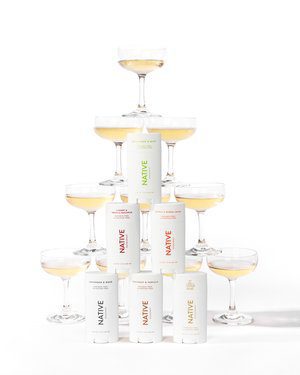


When embarking on a successful skincare marketing campaign, it is necessary to strategically blend innovation, consumer connection, and data-driven insights. For instance, e-commerce is the most effective way to boost beauty retail sales, and social media channels drive these sales the most.
The comprehensive roadmap outlined in this article shows how to craft and execute a compelling skincare campaign—including defining objectives, leveraging industry trends, collaborating with influencers, and implementing analytics.
Each step is designed to elevate your brand’s presence, build trust, and achieve maximum impact. Whether you’re navigating educational content, social media dominance, or email marketing, this guide gives actionable insights to position your skincare brand as a trusted authority.
How to Launch Your Skincare Marketing Campaign
Launching a skincare marketing campaign requires doing a fair amount of research and preparation. The following steps and considerations will help you methodically create a holistic strategy for a successful launch:
Define Your Objectives
Launching a successful skincare marketing campaign involves a strategic approach with clearly defined objectives. Begin by determining your campaign goals. For example, do you want to:
- Build brand awareness,
- Launch a new product,
- Increase customer engagement, or
- Drive sales?
Specify whether you aim to direct the campaign traffic to your direct-to-consumer (DTC) website, Instagram or Facebook page, a retailer’s platform, or another destination.
For this, you’d need to understand your target audience so you can tailor your strategy to meet their specific needs in a way that resonates with them, e.g.:
- Are you promoting efficacious products through testimonials,
- Delivering value-driven messages with discounts, or
- Capitalizing on emerging skincare trends?
Additionally, confirm your goal metrics, whether focused on sales (revenue and number of units sold) or awareness in the form of click-through rates (CTRs) or visitors to the website.
Outlining and identifying your campaign goals gives you a yardstick to measure how successful your campaign is and what must be adjusted in the future.
Another marketing campaign objective is establishing your skincare expertise and authority throughout the campaign. You can showcase your knowledge through informative content, expert endorsements, and engaging narratives.
This helps to reinforce credibility and trust for your brand, strengthening its position in the skincare market.
Market Research and Competitor Analysis
Market research is a foundational step in developing a successful skincare marketing strategy. Conduct a comprehensive analysis of industry trends and consumer preferences to gain insight into the evolving landscape.
For example, identify emerging skincare trends, ingredient preferences, and shifts in consumer behavior. This data will inform your brand positioning and product offerings.
Competitor analysis is essential for understanding the beauty market’s competitive landscape. Examine your competitors’ strategies to identify opportunities and differentiators for your skincare brand. You can learn from their victories (and shortcomings) and leverage this knowledge to refine your approach.
Use A/B testing to optimize your content by experimenting with different messages and visuals to see what resonates best with your target audience. Use generative AI visuals, such as this service from Dillie, to test various visual messages efficiently.
For instance, create diverse imagery reflecting product benefits, lifestyle associations, and brand values, then analyze their success to guide your strategy.
Finally, extend your research beyond the skincare industry by looking at parallel industries like makeup brands, personal care, and consumer goods. Use insights extracted from successful parallel business verticals to further inform your skincare marketing strategy.
Cross-industry analysis can spark innovative ideas and unique approaches to set your brand apart in the crowded market.
Craft a Timeline
Part of launching a skincare marketing campaign involves crafting a timeline. The following is an example of a general timeline, and each step will involve many subtasks:
- Week 1-2: Conduct thorough market research and competitor analysis.
- Week 3-4: Define campaign objectives and target audience.
- Week 5-6: Develop and A/B test content using generative AI visuals.
- Week 7-8: Refine content based on test results.
- Week 9-10: Launch skincare marketing campaign.
- Month 3: Evaluate campaign performance and adjust your strategy if needed.
Confirm a Budget
Confirming a budget for your skincare marketing campaign is critical for allocating resources effectively. Evaluate various marketing levers and choose those that align with your budget while maximizing return on investment (ROI).
Additionally, focus on strategies that resonate with your target audience, e.g., social media advertising, influencer collaborations, and content creation. Consider partnering with a full-service marketing agency like Dillie, which specializes in the beauty industry landscape.
Working with expert marketing strategists ensures a tailored approach that leverages industry insights, bringing a wealth of experience, market trend understanding, and impactful results while optimizing your budget.
Establishing Brand Authority: Leading Skincare Experts
From the get-go, position your brand as the undisputed expert in the industry. You can do this by showcasing in-depth knowledge through informative content, expert endorsements, and scientific backing.
Emphasize your product’s effectiveness by using testimonials for social proof and educational materials. This way, you can reinforce trust and credibility, solidifying your brand’s identity as the go-to authority in skincare.
How to Craft Impactful Skincare Marketing Campaign Content
Crafting compelling content is paramount for a skincare campaign to have maximum impact. Educational content, presented creatively, establishes a strong connection with your audience, fostering trust and loyalty.
There are many ways to craft impactful content, but a multifaceted approach will ensure a broader reach and will likely be more impactful. Here are some ideas:
Educational Content and How-to Videos
Creating educational content and how-to videos is an excellent way to establish your beauty brand as an authority. For example, share valuable skincare tips, industry insights, and detailed product knowledge through engaging blogs, videos, and infographics.
Provide step-by-step guides on using skincare products correctly, e.g., applying certain skincare products at night for optimal results or recommending sun avoidance for two weeks before specific treatments.
Leverage popular short-form content on platforms like YouTube Shorts and TikTok. Be sure to craft visually appealing and informative videos and optimize titles, descriptions, and playlists to boost organic search traffic.
Concise videos that captivate your audience are likelier to drive organic traffic to your sites and reinforce your brand’s expertise.
By delivering valuable information in diverse formats, your skincare marketing campaign will be educational while building a loyal audience base and establishing your brand as a trusted industry authority.
Visual Storytelling
Harness the impact of visual storytelling in your skincare marketing campaign by showcasing high-quality images and videos that highlight your products in action.
For instance, you can take inspiration from successful branded content videos like those from Malin + Goetz to understand how visuals can convey your brand story effectively.
Encourage user-generated content to grow a community around your skincare brand, allowing your customers to share their experiences and testimonials.
By incorporating these and other visually compelling elements, your skincare brand can create an authentic and immersive narrative that resonates with your audience and strengthens the emotional connection with your products.
Testimonials and Review: Social Proof
Leverage the power of testimonials and reviews as potent social proof in your skincare marketing campaign. Showcase before-and-after results to vividly illustrate your products’ efficacy, which helps to instill confidence in potential customers.
Feature real people using your skincare items to provide authentic narratives and demonstrate tangible outcomes. This type of user-generated content is compelling evidence of your product’s effectiveness, building trust and reassuring consumers in their purchase decisions.
By incorporating genuine experiences, testimonials, and reviews, your skincare brand will establish credibility and connect with your audience personally, fostering a sense of authenticity and reliability.
Social Media Domination for Skincare Brilliance
Use social media to showcase your skincare brand’s brilliance and dominance in the industry with the following tips:
Establish Yourself as a Skincare Authority
Achieve social media domination for your skincare brand by establishing authority through strategic partnerships. For instance, you could collaborate with estheticians, dermatologists, and plastic surgeons to lend credibility to your products.
Share clinical data showcasing skincare results, mirroring the approach of industry leaders like Elta MD, who assert their authority in sun safety.
Emulate the success of Skinceuticals CE Ferulic by highlighting your product’s efficacy and value, positioning it as a worthwhile investment. Furthermore, utilize press opportunities to enhance your brand’s credibility.
For instance, Augustinus Bader partnered with makeup artist Bobbi Brown to secure expert recommendations in press outlets, validating their product and building trust.
By aligning with industry experts and leveraging influential endorsements, your skincare brand can dominate social media, gaining trust and recognition within the beauty and skincare community.
Strategic Platform Selection
Select social media platforms strategically, based on your target audience’s habits and preferences ascertained during market research.
Determine where your customers spend their time—whether it’s Pinterest for inspiration, TikTok for short-form entertainment, YouTube for in-depth content, or Instagram for visual storytelling.
Tailor your content calendar to each platform, ensuring your posts remain consistent and engaging, resonating with your audience. By understanding and aligning with your consumer’s preferred platforms, you can maximize your skincare brand’s reach and influence in the digital landscape.
Influencer Collaborations
Collaborating with influencers is an excellent way to amplify your skincare marketing campaign. Partner with skincare influencers to extend your reach and leverage their trusted voice. Encourage influencers to share personal experiences with your products, providing authentic testimonials.
This will help to resonate with their audience and enhance your skincare brand’s credibility.
Define Your Skincare Solution Niche and Be the Go-To Brand
Position your skincare brand as the definitive solution for specific concerns like anti-aging, sun protection, post-surgery healing, acne, and psoriasis. One way to do this is to optimize SEO by incorporating these solutions into product descriptions and blog posts.
You can also showcase your expertise through compelling imagery and by partnering with professionals specializing in relevant fields, like niche-focused influencers, to broaden your reach.
Additionally, build a comprehensive website with videos, photos, blogs, and optimized product page text, establishing your authority. By becoming the go-to brand for targeted skincare needs, you’ll solidify your position in the market and cultivate a loyal customer base that seeks effective solutions from your brand.
Email Marketing: Nurturing Your Skincare Community
In your skincare marketing strategy, prioritize email marketing as a powerful tool to nurture your community in a more personalized manner. Here’s how:
Building a Subscribers List
Implement lead magnets, exclusive offers, and newsletter sign-ups to steadily grow your email list. Using compelling incentives (like free resources) that resonate with your audience will help to encourage subscriptions.
Your email marketing campaign should feature skincare tips, exciting product launches, and exclusive promotions. Creating a sense of exclusivity and value is essential for keeping subscribers engaged.
Segmentation for Personalization
Strategically segment your email list based on the preferences, behaviors, and demographics of your customers. Such segmentation allows for tailored content delivery, ensuring subscribers receive information and offers relevant to their interests.
This personalized approach enhances engagement and conversion rates, fostering a robust connection between your skincare brand and audience.
Analytics and Continuous Optimization
Once you’ve launched your skincare marketing campaign, you must continuously analyze its progress to tweak and optimize it for maximum impact. Here’s how:
Implementing Tracking Tools
Utilize built-in or external analytics tools to diligently monitor your skincare marketing campaign’s performance on social media and your site. Employ social listening tools to quantify your (and your competitor’s) brand and product mentions on social media, providing insight into audience sentiment and engagement.
Google Analytics helps track website traffic and examine user behavior and sources. Affiliate links are also helpful in identifying influencers and user-generated content creators that drive the most site traffic.
Finally, regularly review sales reports to correlate campaign releases and marketing efforts with sale spikes, enabling data-driven optimizations.
Adapting to Emerging Trends
Stay vigilant to evolving skincare trends and seamlessly integrate them into your marketing campaign as a form of optimization. Regularly reassess your approach based on performance metrics, market dynamics, and consumer preferences.
Leverage insights gathered from analytics tools to refine your strategy and adapt swiftly to changing trends. By staying agile and responsive, your skincare brand can maintain relevance and authentically connect with your audience.
Doing this allows you to continually update and optimize your marketing efforts for maximum impact.
Conclusion
In conclusion, launching and sustaining a successful skincare marketing campaign requires a multifaceted and consumer-centric approach. You must define clear objectives, tap into marketing trends, and establish your brand as an industry authority.
Engage your audience through educational content, collaborate with influencers, and choose your platforms strategically. Remember that email marketing and analytics play pivotal roles in community-building and continuous optimization.
Your skincare brand can thrive in a competitive market and foster lasting connections with an informed and loyal community by staying adaptable, embracing emerging trends, and refining strategies based on analytical insights.
Resources
https://www.glamour.com/story/bobbi-brown-skin-care-routinehttps://www.insiderintelligence.com/content/5-charts-that-make-up-beauty-ecommerce

























































